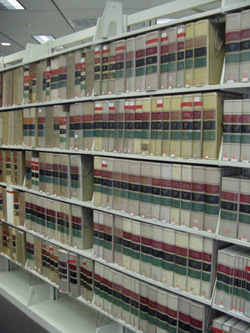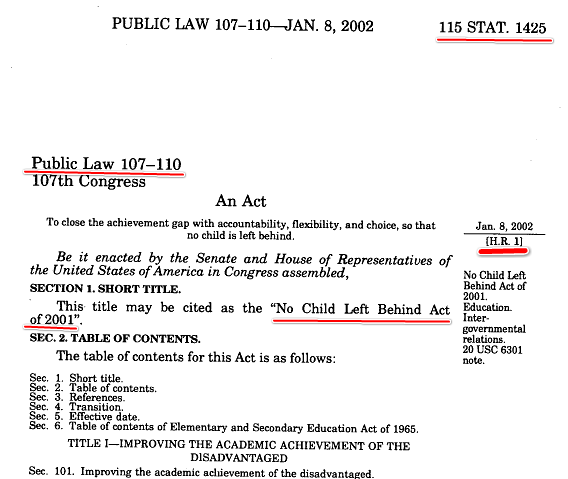
Technically, Congress can pass either "public" or "private" laws, but the vast majority are public ones. Public laws are of general application; private laws benefit a particular person or group.
After a public law is passed, it is first printed in pamphlet form as a slip law. Public laws are assigned a number, the first part being the session of Congress, the second part indicating it was the nth law passed that session (e.g., Pub. L. 107-110).
The second printing of a law comes as one of the session laws printed in the Statutes at Large. These are essentially the slip laws compiled into bound volumes, in chronological order of passage, from a single session of Congress. A Statutes at Large citation (e.g., 115 Stat. 1425) includes the volume and page number on which a law can be found. Since the second number is a page number, this allows for the possibility of a pinpoint cite.
Please note, access to certain databases linked in this guide may be restricted to UT Law or the UT community; please see the library's Databases page that lays out access privileges.

Bluebook citation, Rule 12.4: No Child Left Behind Act, Pub. L. No. 107-110, 115 Stat. 1425 (2002).

View full-text on HeinOnline.
U.S. Code Congressional and Administrative News (USCCAN) is a unique resource published by West, available on Westlaw. It offers two sets of volumes per Congress: one set is a reprint of the Statutes at Large and the other set is labeled "Legislative History," containing lists of citations, abridged reports, and presidential signing statements.
Thus USCCAN has characteristics of both a compilation and a list of citations. However, because it reprints only highlights from a law's legislative history, it is not a comprehensive source as either a compilation or a list. Still, it can be quite convenient to use--you will find references to the relevant portions of USCCAN listed by section in the USCA. Because it focuses on the highlights, it can be a good first source to check.
Westlaw's "Graphical Statutes" and "Legislative History" Features
In addition to compiled legislative histories, Westlaw offers two features that are integrated into the search results from the USCA or Public Laws databases. In the History tab for a specific statute or code section, you may find the Graphical Statute and Legislative History features.
The Graphical Statutes feature offers a visual timeline of the changes to a section of the Code. Keep in mind, however, that it is still worthwhile to seek out a full compiled history or a list of citations for comparison.
The Legislative History materials can include documents such as bill drafts, reports, hearing testimony, the Congressional Record, and signing statements. Note however that the links provided for testimony are unofficial transcripts of hearings (not the final, official versions that are published later), and that this collection of materials may not be comprehensive. Again, it is wise to consult a compiled legislative history or list of citations whenever possible.
Originally, a "chapter" number was assigned to each law passed. Beginning in 1901, Public (or Private) Law numbers were added. In 1957 the modern system of numbering with a Congress-number prefix was adopted, and chapter numbering was discontinued. (Thus, between 1901 and 1957, chapters and Public Law citation system ran concurrently. although there were some inconsistencies.)
Ex: 34 Stat. 864
